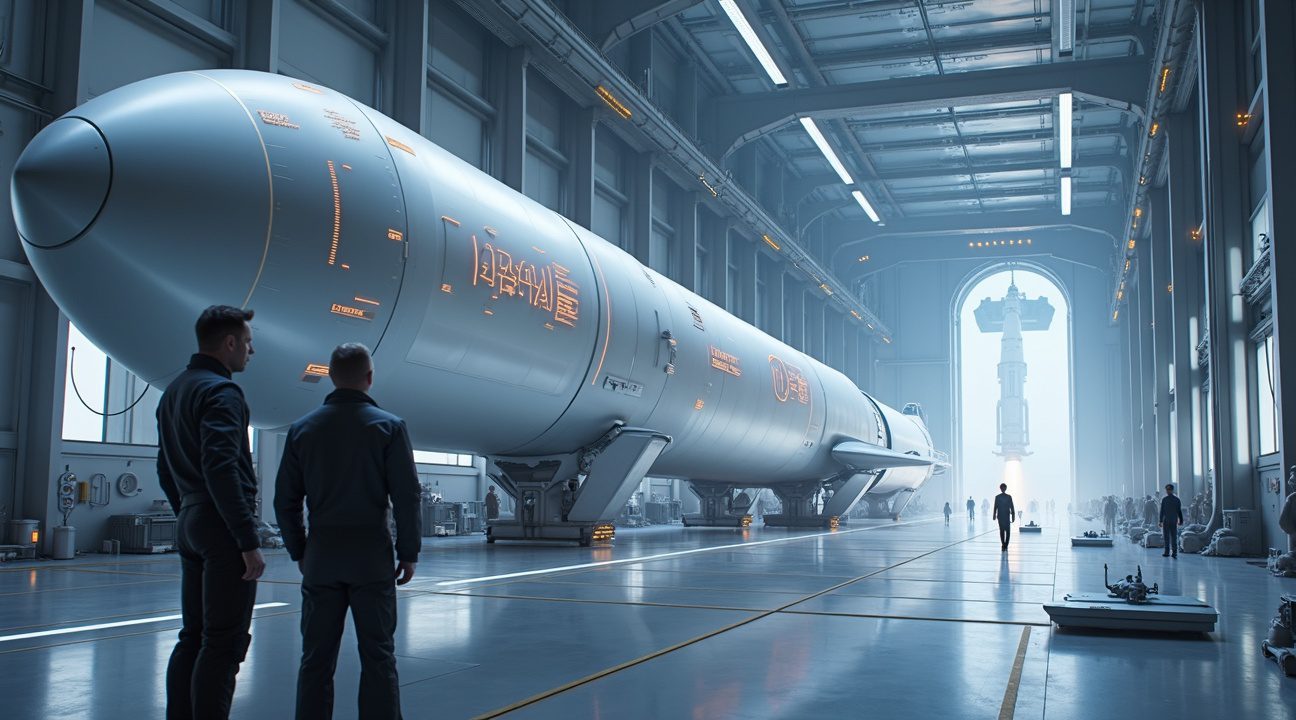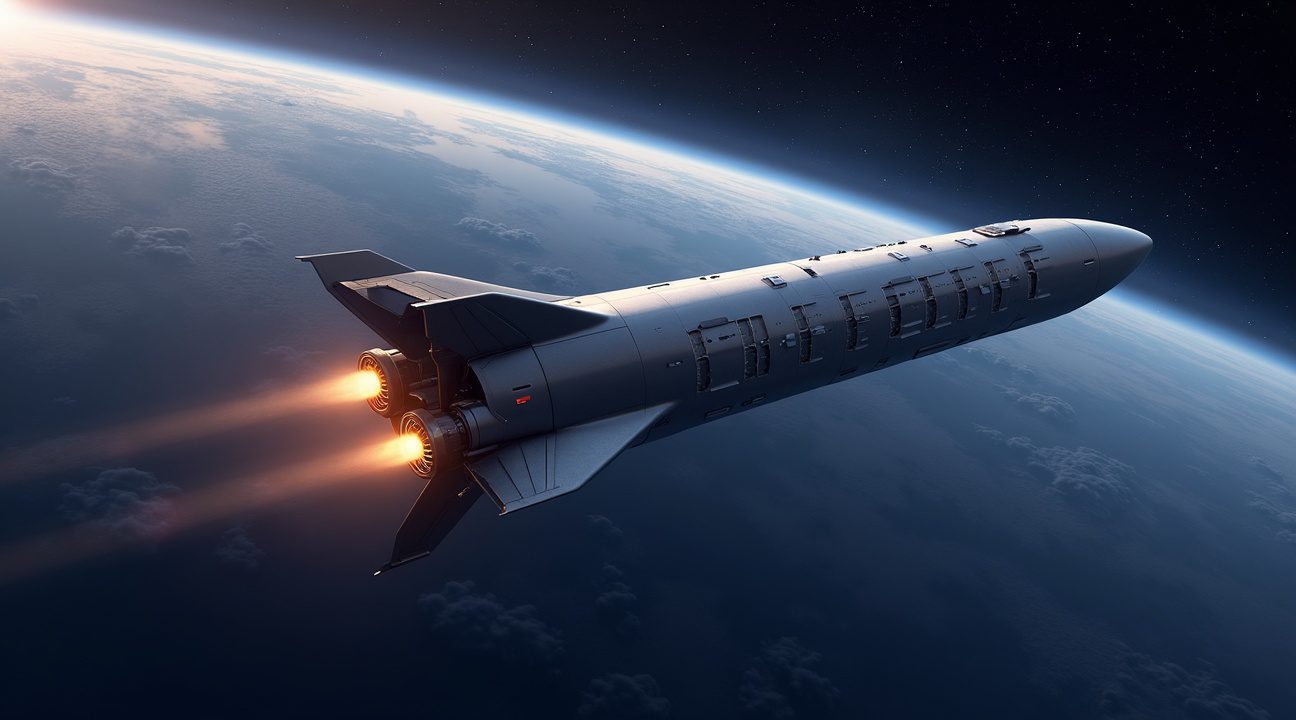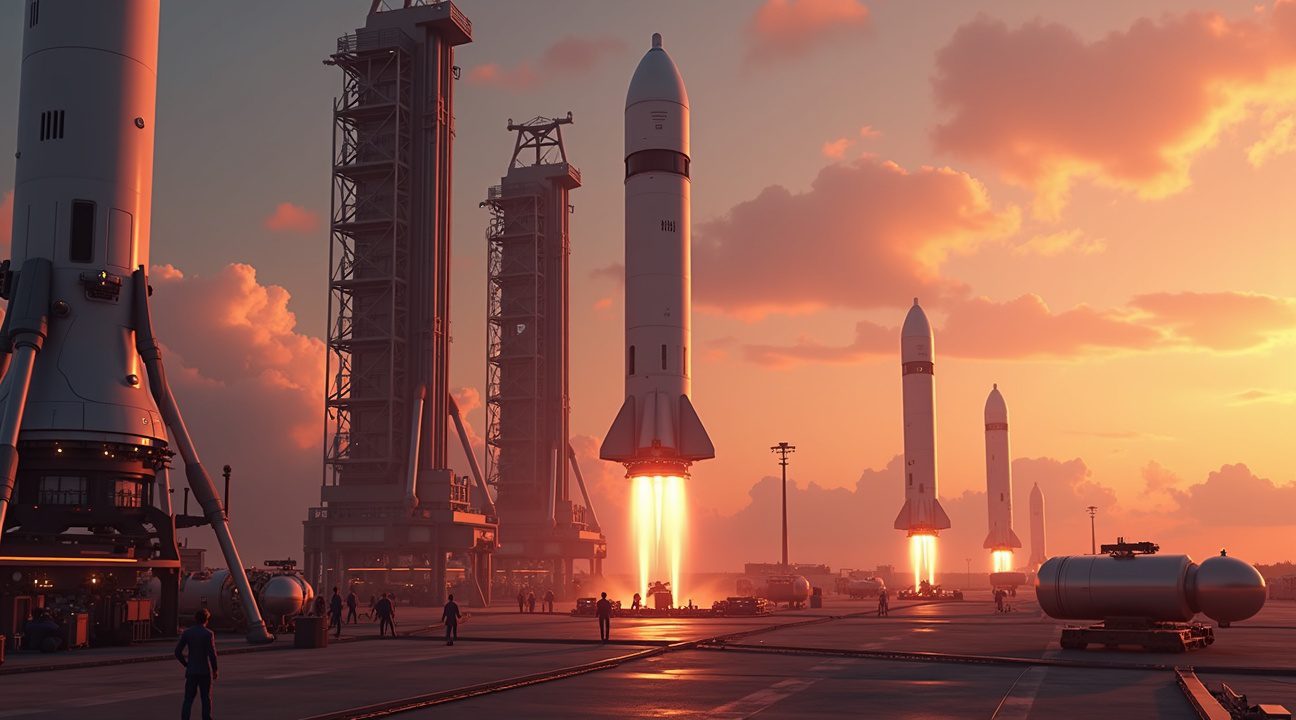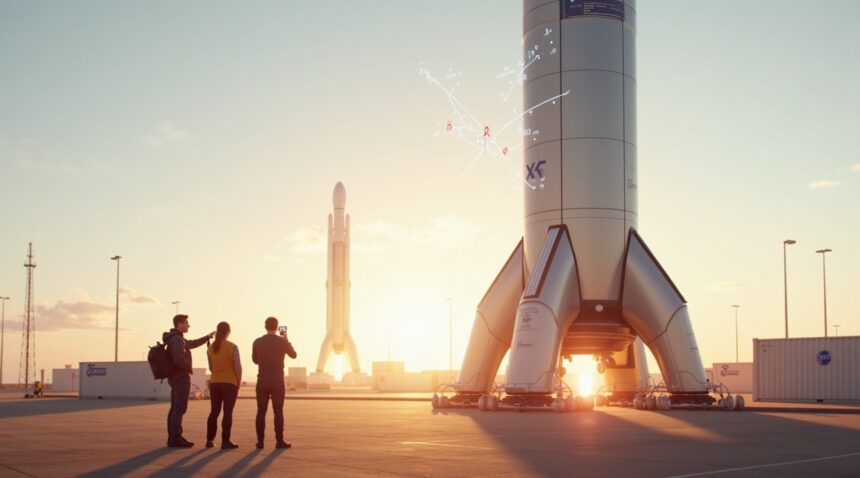A simple question from a YouTuber during a SpaceX facility tour prompted Elon Musk to implement a groundbreaking engineering change that eliminates separate cold gas thruster systems on Starship.
Key Takeaways
- Waste-to-thrust innovation: SpaceX now redirects excess gases from main engines to power maneuvering thrusters instead of venting them into space, eliminating the need for separate nitrogen-based control systems.
- Significant weight reduction: Removing dedicated cold gas tanks and associated hardware increases payload capacity and improves mission performance by reducing overall spacecraft mass.
- Faster turnaround times: The integrated system uses the same propellants as main engines, streamlining refueling operations and enabling rapid reusability with potential turnaround times under one hour.
- Simplified maintenance: Fewer subsystems mean reduced complexity, lower failure risk, and less maintenance between flights, supporting SpaceX’s goal of airline-like operational frequency.
- External innovation catalyst: The breakthrough demonstrates how SpaceX’s open approach to community engagement and willingness to consider outside perspectives drives technical advancement and problem-solving.
This engineering revolution exemplifies how SpaceX transforms traditional aerospace thinking. Most spacecraft separate their primary propulsion from attitude control systems, using different propellants for each function. SpaceX challenged this conventional wisdom by recognizing that Raptor engines naturally produce excess gases during normal operation.
The company previously vented these excess gases into space as waste. Now, SpaceX captures and redirects this flow to dedicated attitude control thrusters positioned around Starship’s hull. This approach eliminates the entire cold gas system that would have required separate tanks, valves, and nitrogen storage.
Weight savings cascade throughout the vehicle design. Removing cold gas tanks frees up internal volume for payload or additional fuel. Eliminating redundant plumbing reduces complexity and potential failure points. The integrated approach also simplifies ground operations since crews only need to load methane and oxygen instead of managing multiple propellant types.
SpaceX‘s willingness to listen to outside perspectives continues driving innovation. The YouTuber’s question highlighted an opportunity that internal teams might have overlooked due to conventional thinking. This openness to external input reflects the company’s culture of continuous improvement and technical excellence.
The modification supports SpaceX’s rapid reusability goals. Using identical propellants for both main engines and attitude control eliminates propellant switching during turnaround operations. Ground crews can focus on single-point refueling processes, potentially achieving the one-hour turnaround times that SpaceX envisions for operational Starship missions.
This innovation demonstrates how questioning basic assumptions leads to breakthrough solutions. While other companies accept traditional spacecraft architectures, SpaceX consistently challenges established practices to achieve superior performance and operational efficiency.
How a YouTuber’s Question Catalyzed a Key Engineering Change
During a visit to SpaceX’s Starbase facility, YouTuber Everyday Astronaut posed a question that would trigger an unexpected engineering breakthrough. The inquiry focused on outgassing from Starship’s main engines, a seemingly minor detail that caught Elon Musk’s attention in a profound way.
From Waste Gas to Propulsion Innovation
Musk’s response to this question led to a fundamental shift in how SpaceX approaches maneuvering thrusters on Starship. The excess gas produced by the main engines, previously considered waste, could serve a dual purpose as propellant for the spacecraft’s attitude control system.
Traditional spacecraft design requires separate systems for different functions. Maneuvering thrusters typically depend on dedicated tanks filled with cold gas, usually nitrogen, to provide precise directional control. This conventional approach brings several challenges:
- Additional mass from separate tank systems
- Increased structural complexity
- Higher manufacturing costs
- More potential failure points
SpaceX’s revised design eliminates these inefficiencies by redirecting main engine outgassing directly to the maneuvering thrusters. This integration reduces overall spacecraft mass while simplifying the propulsion architecture. Engineers can now achieve the same control capabilities without carrying dedicated cold gas systems.
The modification demonstrates how external perspectives can spark innovation within established engineering teams. Musk’s willingness to consider questions from content creators reflects SpaceX’s culture of continuous improvement. Rather than dismissing input from outside the organization, the company embraces fresh viewpoints that challenge existing assumptions.
This change extends beyond simple weight reduction. System redundancy decreases when multiple functions share common components, but operational efficiency increases significantly. The integrated approach allows Starship to carry more payload or fuel while maintaining precise control authority throughout its mission profile.
The interaction between Everyday Astronaut and Musk illustrates how accessible communication can drive technical advancement. Complex engineering problems sometimes require simple questions to reveal overlooked solutions. SpaceX’s openness to external input has consistently produced innovative results across multiple vehicle programs.
This propulsion system refinement represents another step forward in Starship’s development. Each modification brings the vehicle closer to operational readiness while reducing costs and improving reliability. The YouTube question that started this particular improvement cycle shows how collaborative engineering can emerge from unexpected sources.

Details of the Solution: Repurposing Excess Gas for Thrust
The ingenious solution involves redirecting unused methane and oxygen from Starship’s powerful Raptor engines to create thrust for vehicle control. Rather than venting these valuable propellants into space, SpaceX engineers found a way to harness them for precise maneuvering during flight operations.
How the Gas Redirection System Works
The integrated propulsion system captures excess gases that would normally be wasted during engine operation. These redirected propellants get channeled through specialized thrusters positioned around Starship’s body, creating the control forces needed for attitude adjustments and orbital maneuvers. This approach eliminates the traditional requirement for separate high-pressure nitrogen tanks that previous spacecraft designs relied upon for reaction control.
The weight savings from removing dedicated control gas systems prove substantial. Every kilogram saved translates directly into increased payload capacity or additional fuel for mission operations. Elon Musk’s Mars colonization plans heavily depend on maximizing cargo capacity, making these efficiency gains crucial for future interplanetary missions.
Key advantages of using redirected engine gases include:
- Reduced spacecraft weight
- Streamlined fuel systems (uses same propellants as main engines)
- Faster turnaround times between launches
- Simplified maintenance and operations
- Improved system reliability through fewer components
Rapid reuse capabilities receive a significant boost from this design change. Traditional nitrogen-based reaction control systems require time-consuming refueling between flights, often involving specialized ground equipment and lengthy turnaround procedures. The new methane-oxygen system uses the same propellants as the main engines, streamlining refueling operations and reducing ground processing time between missions.
SpaceX’s engineering team demonstrated remarkable innovation by recognizing that engine bleed gases could serve dual purposes. The Raptor engines naturally produce excess methane and oxygen during certain flight phases, particularly during throttling operations and engine shutdown sequences. Instead of treating these gases as waste products, the new system captures and redirects them through dedicated control thrusters.
This solution exemplifies how SpaceX’s innovative approach continues pushing aerospace engineering boundaries. The integrated propulsion concept reduces system complexity while improving performance—a rare achievement in spacecraft design where trade-offs typically dominate engineering decisions.
Additional practical benefits include:
- Decreased maintenance due to fewer subsystems
- Minimized fluid handling at launch sites
- Accelerated launch preparation workflows
- Lower failure risk due to reduced component count
Flight reliability improves through system integration rather than multiplication of failure points. Each additional system traditionally adds potential failure modes, but this solution actually reduces overall system count while maintaining full control authority throughout mission profiles.

The Original Technical Challenge with Starship’s Maneuvering System
I’ve studied the original Starship design challenges extensively, and the standalone cold gas thruster systems presented significant engineering obstacles that directly impacted mission capabilities. These systems fundamentally increased the vehicle’s dry mass while simultaneously creating operational headaches for rapid reusability goals.
Mass Penalty and Performance Impact
The dry mass problem can’t be overstated when examining Starship’s scale. The upper stage weighs over 20 times more than Falcon 9, making every single kilogram a critical consideration for payload capacity and vehicle economics. Cold gas tanks represented dead weight that didn’t contribute to primary propulsion but consumed precious mass budget. This weight penalty directly translated into reduced payload capacity or decreased operational margins for missions.
SpaceX’s reusability strategy demands vehicles that can fly frequently with minimal refurbishment. However, cold gas systems inherently worked against this goal by adding components that required regular maintenance and inspection cycles between flights.
System Complexity and Reliability Concerns
Beyond mass considerations, standalone cold gas thrusters introduced multiple additional failure points into an already sophisticated vehicle design. Each thruster required its own valves, lines, and control systems, creating a web of components that could potentially malfunction. The complexity extended beyond just the thrusters themselves to encompass:
- Dedicated storage tanks requiring pressurization systems
- Independent plumbing networks separate from main propulsion
- Additional sensors and control hardware for precise maneuvering
- Specialized refurbishment procedures between flights
This complexity directly contradicted Elon Musk’s Mars colonization philosophy of building simple, maintainable systems that could operate reliably in remote environments. Mars missions can’t afford complex subsystems that might fail without readily available spare parts or specialized maintenance facilities.
The refurbishment burden became particularly problematic for SpaceX’s rapid launch cadence goals. While Falcon 9 achieved remarkable reusability success, Starship’s cold gas systems threatened to create maintenance bottlenecks that could slow turnaround times between missions. Each flight required thorough inspection of thruster systems, tank integrity checks, and potential component replacement — all activities that consumed valuable time and resources in the launch preparation process.
Impacts on Starship’s Reusability and Performance
The breakthrough directly addresses SpaceX’s ambitious vision of transforming rocketry from a disposable industry into something resembling commercial aviation. This innovation dramatically accelerates the path to colonize Mars by enabling unprecedented launch frequency.
Revolutionary Turnaround Times
Traditional aerospace operations require extensive refurbishment periods between flights, often stretching weeks or months. SpaceX has shattered this paradigm with Starship booster catch cycles that can complete in just 1–2 hours. The company’s launch tower arms now catch returning boosters with precision, eliminating the need for costly recovery operations at sea.
Refueling procedures have been streamlined to 30–40 minutes, creating theoretical turnaround times of under one hour. This represents a fundamental shift from traditional rocketry operations to something more closely resembling airline scheduling. Commercial airlines don’t rebuild their engines between flights—they refuel, perform safety checks, and launch again.
Multiple Daily Flights and Commercial Implications
SpaceX’s ultimate goal involves multiple reflights per day from the same vehicle. This rapid reusability model creates several cascading advantages that benefit both the company and its customers:
- Dramatically reduced per-flight costs through amortization of vehicle development expenses
- Increased commercial payload cadence allowing more frequent satellite deployments
- Enhanced mission flexibility with shorter notice periods for launch scheduling
- Greater redundancy options if technical issues arise with individual vehicles
- Accelerated testing cycles that compress development timelines for future improvements
The implications extend far beyond cost savings. Commercial customers can now plan missions with airline-like reliability rather than accepting the traditional uncertainty of space operations. Satellite constellations can deploy faster, scientific missions can launch with reduced waiting periods, and emergency payload deployments become feasible.
Flight cycles that previously consumed months of preparation can now repeat within hours. This transformation affects every aspect of space commerce, from constellation maintenance to interplanetary cargo delivery. Elon Musk’s acquisition strategy across multiple industries reflects this same disruptive approach—taking established practices and reimagining them completely.
The booster catch system eliminates the complexity and expense of ocean recovery operations. Landing legs become unnecessary, reducing vehicle weight and increasing payload capacity. Launch tower infrastructure handles the mechanical stress of catching multi-ton boosters, while ground crews can immediately begin turnaround procedures.
Performance metrics improve across multiple dimensions simultaneously. Payload capacity increases when vehicles don’t carry recovery hardware. Launch windows expand when turnaround times shrink. Mission costs plummet when the same vehicle flies dozens of times rather than once.
This rapid reusability model creates a positive feedback loop for SpaceX’s broader objectives. More frequent flights generate more operational data, accelerating vehicle improvements. Higher flight rates reduce per-mission costs, making space access affordable for new market segments. Increased launch cadence supports larger payload manifests, enabling more ambitious mission architectures.
The innovation particularly benefits time-sensitive commercial applications. Emergency satellite replacements, rapid constellation updates, and responsive national security launches all become viable when launch vehicles operate on aviation-like schedules rather than traditional rocket timelines.

Community and Open Source Problem-Solving at SpaceX
The interaction between Everyday Astronaut and SpaceX demonstrates how the company has revolutionized traditional aerospace development through unprecedented openness. While most rocket manufacturers operate behind closed doors, SpaceX actively welcomes external scrutiny and transforms it into actionable improvements. This approach has proven particularly effective at Starbase, where engineers regularly engage with YouTubers, journalists, and space enthusiasts who bring fresh perspectives to complex engineering challenges.
Real-Time Engineering Through Public Engagement
SpaceX’s willingness to adapt designs based on external feedback creates several key advantages for rapid development:
- Direct access to diverse expertise from the global aerospace community
- Immediate identification of potential design flaws before costly manufacturing phases
- Enhanced public understanding and support for ambitious space projects
- Accelerated iteration cycles that compress typical development timelines
- Cross-pollination of ideas from adjacent industries and academic institutions
The company’s Mars colonization goals benefit significantly from this collaborative model. Engineers working on Starship receive input from metallurgists, propulsion experts, and even amateur rocket builders who spot issues that internal teams might overlook. This external validation process has prevented numerous potential failures while maintaining SpaceX’s aggressive development schedule.
Traditional aerospace companies typically shield their designs from public view until completion, often discovering critical flaws late in development. SpaceX’s transparent approach allows for continuous refinement throughout the design process. Young engineers joining the company find themselves working in an environment where questioning established practices is encouraged rather than discouraged.
The Starbase Q&A sessions exemplify this philosophy in action. Engineers present current designs to knowledgeable audiences who ask pointed questions about structural integrity, thermal management, and operational efficiency. These sessions often lead to immediate design modifications that improve safety margins and performance characteristics. The iterative development cycle benefits from this constant feedback loop, allowing SpaceX to refine concepts before committing significant resources to production.
Fan influence extends beyond casual observation to substantive technical contributions. Space enthusiasts with specialized knowledge in materials science, aerodynamics, or manufacturing processes regularly provide insights that influence design decisions. This crowdsourced approach to problem-solving leverages collective intelligence while maintaining rigorous engineering standards. Public scrutiny through social media platforms ensures that proposed solutions undergo thorough vetting before implementation.
The collaborative design process extends to SpaceX’s supplier network and academic partnerships. Universities contribute research findings while component manufacturers suggest alternative materials or production methods based on their specialized expertise. This ecosystem approach accelerates innovation by incorporating knowledge from multiple domains simultaneously. Manufacturing techniques developed for automotive applications find their way into rocket production, while advances in consumer electronics inform avionics design.
SpaceX’s open approach contrasts sharply with competitors who view external input as potential security risks or intellectual property threats. The company’s confidence in its core competencies allows it to share technical details without fear of losing competitive advantages. This transparency builds trust with regulatory agencies, potential customers, and the general public while attracting top talent who want to work in an environment that values diverse perspectives.
Family influence within the company also reflects this collaborative spirit, with multiple generations contributing different viewpoints to technical challenges. The company’s culture encourages questioning assumptions regardless of hierarchy or experience level, creating an environment where the best ideas rise to the surface through merit rather than politics.
Social media platforms serve as additional channels for receiving feedback on announced designs or test results. Engineers monitor these discussions for valuable insights that might emerge from unexpected sources. Amateur analysts often spot patterns in test data that busy development teams might miss, leading to refinements in subsequent iterations. This continuous feedback mechanism ensures that each design iteration incorporates lessons learned from the broader community’s observations and suggestions.
Sources:
Everyday Astronaut – Elon Musk’s Starship Innovation (TikTok, Aug 2025)
“This YouTuber’s question to Elon Musk at SpaceX’s Starbase led to a major Starship improvement: using main engine excess gas for maneuvering thrusters!” (TikTok)
NASA revealed The Big Problem Inside SpaceX’s Starship! (Space Zone, YouTube, Aug 2025)
Elon Musk talks SpaceX Starship’s potential to transform space exploration in new update (YouTube, Aug 2025)
Elon Musk Just Gave The Starship Update Everyone Was Waiting For (YouTube, Aug 2025)
YouTuber’s Question Helps Elon Musk Improve Starship (YouTube Shorts, 2022)


